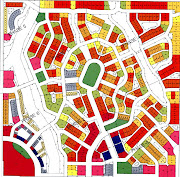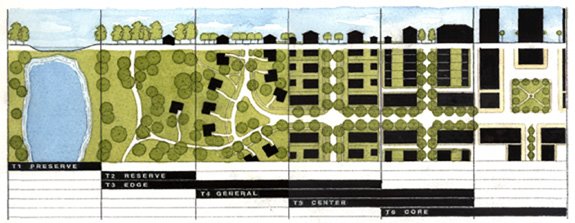Wednesday, December 27, 2006
Top 10 Trends That Shaped U.S. Cities in 2006
Top 10 Trends That Shaped U.S. Cities in 2006
Click here to refresh: http://www.newherbanism.blogspot.com/
For 10 years, Brookings Institution’s Metropolitan Policy Program has charted trends and highlighted challenges facing America’s metro areas. This year’s big picture: Statistics might portray an economy on the rebound, but many parts of the country and many households don’t share in that success.
Ten noteworthy trends, according to Brookings, that standout for 2006:
1. For the first time, there are more poor residents in the suburbs than in central cities.
2. Six percent of the population in large U.S. metropolitan areas live in exurbs, communities on the fringe of urban centers. Exurb characteristics: 20 percent of workers commute to city jobs; low housing density; high population growth.
3. More than one-third of the nation's loss of manufacturing jobs between 2000 and 2005 occurred in seven Great Lakes states: Illinois, Indiana, Michigan, New York, Ohio, Pennsylvania, and Wisconsin.
4. America's older, inner-ring first suburbs, the earliest suburbs that sprang up around center cities before and during World War II, make up 20 percent of the nation's population and are more diverse and older than the nation as a whole.
5. The average U.S. household spends 19 percent of its budget on transportation, rendering household location a key component of housing affordability.
6. Nationwide, more than 4.2 million lower income home owners pay a higher than average APR for their mortgage. Lower income households, those earning less than $30,000, pay 6.9 percent compared with an average rate of 6.5 percent for those earning $30,000 to $60,000. Those with incomes above $120,000 paid a rate of approximately 5.5 percent.
7. The leading refugee destination metro areas have shifted away from traditional immigrant gateways, such as Los Angeles and New York, over the past two decades to newer gateways, such as Atlanta, Portland, Seattle.
8. The fastest-growing metropolitan areas for minority populations from 2000 to 2004 now closely parallel the fastest-growing areas in the nation. Las Vegas, Atlanta, Orlando, and Phoenix are now prominent centers of minority population growth.
9. Middle-income neighborhoods as a proportion of all metropolitan neighborhoods declined to 41 percent in 2000 from 58 percent in 1970, disappearing faster than the share of middle class households in these metro areas.
10. Of the $109 billion in federal appropriations dedicated to Gulf Coast funding in the first year after Hurricane Katrina, only about $35 billion went toward the long-term recovery of the region.
Source: Camilla McLaughlin for REALTOR® Magazine Online, December 27, 2006
Click here to refresh: http://www.newherbanism.blogspot.com/
For 10 years, Brookings Institution’s Metropolitan Policy Program has charted trends and highlighted challenges facing America’s metro areas. This year’s big picture: Statistics might portray an economy on the rebound, but many parts of the country and many households don’t share in that success.
Ten noteworthy trends, according to Brookings, that standout for 2006:
1. For the first time, there are more poor residents in the suburbs than in central cities.
2. Six percent of the population in large U.S. metropolitan areas live in exurbs, communities on the fringe of urban centers. Exurb characteristics: 20 percent of workers commute to city jobs; low housing density; high population growth.
3. More than one-third of the nation's loss of manufacturing jobs between 2000 and 2005 occurred in seven Great Lakes states: Illinois, Indiana, Michigan, New York, Ohio, Pennsylvania, and Wisconsin.
4. America's older, inner-ring first suburbs, the earliest suburbs that sprang up around center cities before and during World War II, make up 20 percent of the nation's population and are more diverse and older than the nation as a whole.
5. The average U.S. household spends 19 percent of its budget on transportation, rendering household location a key component of housing affordability.
6. Nationwide, more than 4.2 million lower income home owners pay a higher than average APR for their mortgage. Lower income households, those earning less than $30,000, pay 6.9 percent compared with an average rate of 6.5 percent for those earning $30,000 to $60,000. Those with incomes above $120,000 paid a rate of approximately 5.5 percent.
7. The leading refugee destination metro areas have shifted away from traditional immigrant gateways, such as Los Angeles and New York, over the past two decades to newer gateways, such as Atlanta, Portland, Seattle.
8. The fastest-growing metropolitan areas for minority populations from 2000 to 2004 now closely parallel the fastest-growing areas in the nation. Las Vegas, Atlanta, Orlando, and Phoenix are now prominent centers of minority population growth.
9. Middle-income neighborhoods as a proportion of all metropolitan neighborhoods declined to 41 percent in 2000 from 58 percent in 1970, disappearing faster than the share of middle class households in these metro areas.
10. Of the $109 billion in federal appropriations dedicated to Gulf Coast funding in the first year after Hurricane Katrina, only about $35 billion went toward the long-term recovery of the region.
Source: Camilla McLaughlin for REALTOR® Magazine Online, December 27, 2006
Thursday, December 07, 2006
Herb on the Radio . . . Again!
1110 KFAB at 8:00 AM Saturday, December 9, 2006 . . .
Click here to refresh: http://www.newherbanism.blogspot.com/
My next guest shot on the radio will be on the Grow Omaha show which airs at 8:00 a.m. every Saturday morning on radio 1110AM KFAB. Grow Omaha is hosted by Trenton Magid and Jeff Beals with Coldwell Banker Commercial World Group. I will be on the show this Saturday, December 9th.
The KFAB call-in numbers are 558-1110 or 1-800-543-1110.
Be sure to tune in right at 8:00 because I will be on during the first half of the program. Call in and support traditional neighborhood development in the Omaha area.
Thanks for your continuing interest,
Herb
Tuesday, December 05, 2006
Let's Say Thanks . . .
Click here to refresh: http://www.newherbanism.blogspot.com/
Here is something cool that Xerox is doing: if you go to this web site, www.LetsSayThanks.com, you can pick out a thank you card, add a message and Xerox will print it and send it to a soldier who is currently serving in Iraq. You can't pick out who gets your card, but it will go to some member of the armed services.
How amazing it would be if every service memember got a card this Holiday season thanking him or her for serving our nation. Please send a card. Send several. It is FREE, annonymous and it only takes a second. Forward this link on to your family and friends after you send your card. It will make you feel wonderful.
Here is something cool that Xerox is doing: if you go to this web site, www.LetsSayThanks.com, you can pick out a thank you card, add a message and Xerox will print it and send it to a soldier who is currently serving in Iraq. You can't pick out who gets your card, but it will go to some member of the armed services.
How amazing it would be if every service memember got a card this Holiday season thanking him or her for serving our nation. Please send a card. Send several. It is FREE, annonymous and it only takes a second. Forward this link on to your family and friends after you send your card. It will make you feel wonderful.
Subscribe to:
Posts (Atom)


